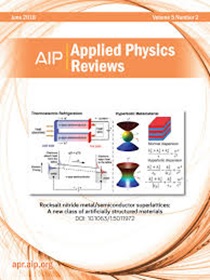Weyl型半金属WP2+δ晶体中巨手性磁效应的实验证据
IF 11.6
1区 物理与天体物理
Q1 PHYSICS, APPLIED
引用次数: 0
摘要
手性磁效应(CME)是相对论性Weyl费米子在平行电场(E)和磁场(B)下由于量子涨落而导致手性对称性被破坏而产生的一种量子现象。直观地说,手性相反的Weyl费米子在平行的E和B的刺激下,会产生不同的化学势,从而产生额外的电流,其作用就像固体中的手性电池。然而,到目前为止,手性磁效应的实验证据是负纵向磁电阻,而不是手性电源。在这里,与以往的报道不同,我们在ii型Weyl半金属WP2+δ中观察到一个巨大的手性磁效应,其“负”电阻和相应的电压-电流曲线位于第二-四象限。这些现象发生在以下条件下:B和E的错向角小于20°,温度小于40 K,外加电流小于50 mA,磁场大于3 t。从现象上看,基于宏观的Chern-Simons-Maxwell方程,WP2+δ中观察到的巨大手性磁效应归因于Weyl费米子的手性,其相干时间比Drude输运弛豫时间长两阶。我们的发现提供了Weyl半金属中巨大的手性-磁性/手性-电池效应的证据。本文章由计算机程序翻译,如有差异,请以英文原文为准。
Experimental evidence of giant chiral magnetic effect in type-II Weyl semimetal WP2+δ crystals
The chiral magnetic effect (CME) is a quantum phenomenon arising from the breaking of chiral symmetry in relativistic Weyl fermions due to quantum fluctuations under parallel electric (E) and magnetic fields (B). Intuitively, Weyl fermions with opposite chirality, under the stimulus of parallel E and B, will have different chemical potentials that give rise to an extra current, whose role is like a chiral battery in solids. However, up until now, the experimental evidence for the chiral magnetic effect is the negative longitudinal magnetoresistance, rather than a chiral electric source. Here, different from previous reports, we observed a giant chiral magnetic effect evidenced by “negative” resistance and corresponding voltage–current curves located in the second-fourth quadrant in the type-II Weyl semimetal WP2+δ. These phenomena occur under the following conditions: the misalignment angle between B and E is smaller than 20°, the temperature is below 40 K, the externally applied electrical current is less than 50 mA, and the magnetic field is larger than 3 T. Phenomenologically, based on the macroscopic Chern–Simons–Maxwell equation, this giant chiral magnetic effect observed in WP2+δ is attributed to the chirality of Weyl fermions possessing a two-order longer coherent time than the Drude transport relaxation time. Our findings provide evidence of the giant chiral-magnetic/chiral-battery effect in Weyl semimetals.
求助全文
通过发布文献求助,成功后即可免费获取论文全文。
去求助
来源期刊

Applied physics reviews
PHYSICS, APPLIED-
CiteScore
22.50
自引率
2.00%
发文量
113
审稿时长
2 months
期刊介绍:
Applied Physics Reviews (APR) is a journal featuring articles on critical topics in experimental or theoretical research in applied physics and applications of physics to other scientific and engineering branches. The publication includes two main types of articles:
Original Research: These articles report on high-quality, novel research studies that are of significant interest to the applied physics community.
Reviews: Review articles in APR can either be authoritative and comprehensive assessments of established areas of applied physics or short, timely reviews of recent advances in established fields or emerging areas of applied physics.
 求助内容:
求助内容: 应助结果提醒方式:
应助结果提醒方式:


